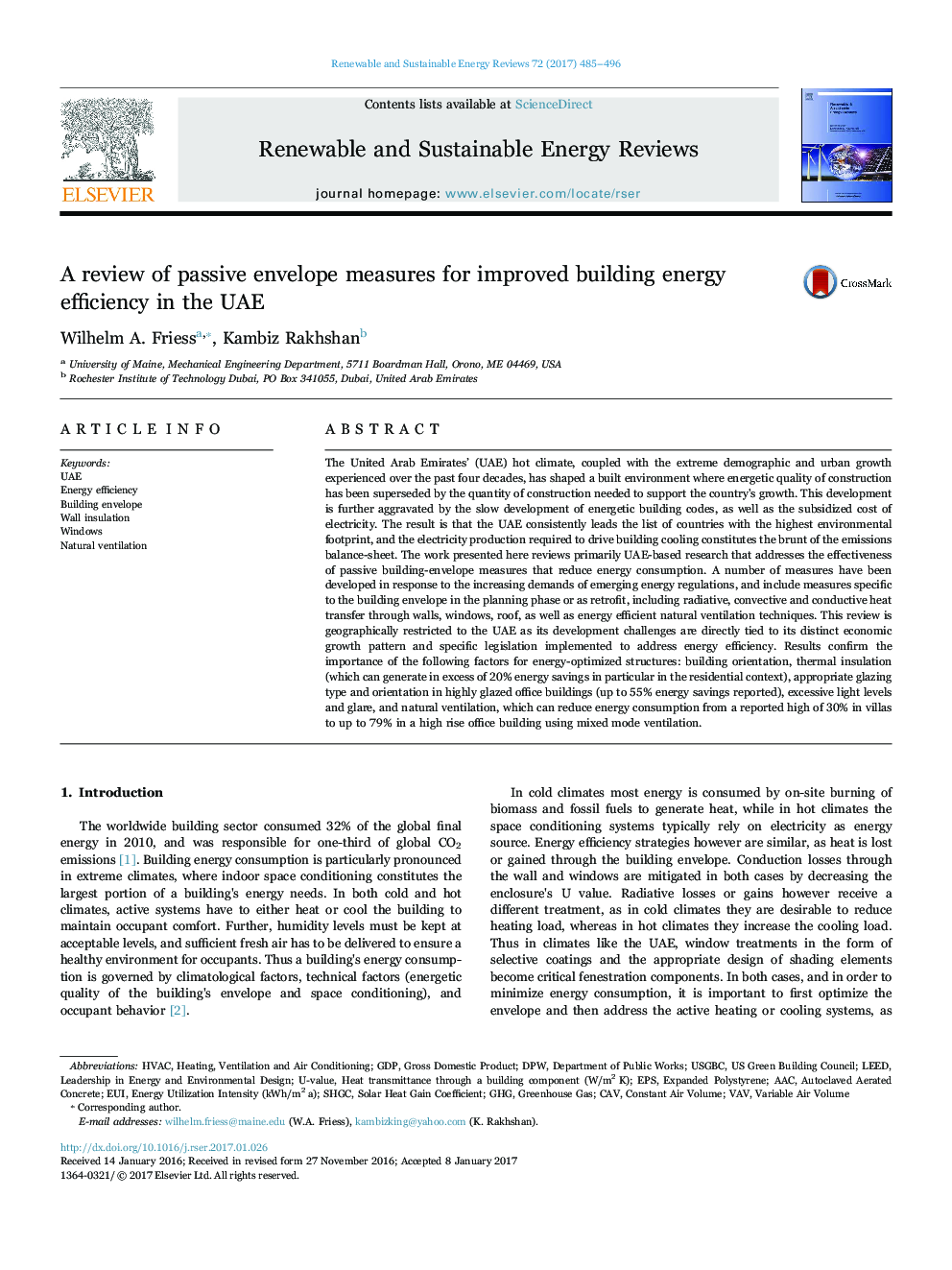| کد مقاله | کد نشریه | سال انتشار | مقاله انگلیسی | نسخه تمام متن |
|---|---|---|---|---|
| 5482382 | 1522314 | 2017 | 12 صفحه PDF | دانلود رایگان |
عنوان انگلیسی مقاله ISI
A review of passive envelope measures for improved building energy efficiency in the UAE
ترجمه فارسی عنوان
بازبینی اقدامات پاکت گذار برای بهبود کارایی انرژی ساختمان در امارات متحده عربی
دانلود مقاله + سفارش ترجمه
دانلود مقاله ISI انگلیسی
رایگان برای ایرانیان
کلمات کلیدی
Constant Air VolumeEUIDpWSHGCVAVLEEDAACEPSGHGCAVU-value - ارزش UUAE - امارات متحده عربیAutoclaved aerated concrete - بتن هوادهی اتوکلاوEnergy efficiency - بهره وری انرژیNatural ventilation - تهویه طبیعی HVAC - تهویه مطبوعGross domestic product - تولید ناخالص داخلیGDP - تولید ناخالص ملیVariable air volume - حجم هوا متغیرLeadership in Energy and Environmental Design - رهبری در طراحی انرژی و محیط زیستSolar heat gain coefficient - ضریب به دست آوردن گرما خورشیدیWall insulation - عایق دیوارBuilding envelope - پاکت ساختمانExpanded polystyrene - پلی استایرنWindows - پنجره هاGreenhouse gas - گاز گلخانه ایHeating, Ventilation and Air Conditioning - گرمایش، تهویه و تهویه مطبوع
ترجمه چکیده
آب و هوای گرم امارات متحده عربی (امارات متحده عربی) همراه با رشد شدید جمعیت و جمعیت شهری طی چهار دهه گذشته، محیط زیستی را ایجاد کرده است که در آن کیفیت ساخت و ساز پر انرژی با مقدار ساختمانی مورد نیاز برای حمایت از رشد کشور جایگزین شده است . این توسعه بیشتر با توسعه آهسته کدهای ساختمان پر انرژی، و همچنین هزینه یارانه برق، تشدید می شود. نتیجه این است که امارات متحده عربی به طور مداوم فهرست کشورهای با بالاترین میزان محیط را به ارمغان می آورد و تولید برق مورد نیاز برای رانندگی خنک کننده ساختمان، مهم ترین تسلیحات منتشر شده است. کار ارائه شده در اینجا بررسی عمدتا در امارات متحده عربی مبتنی بر تحقیق است که در مورد اثربخشی اقدامات منفعل ساختمان، کاهش مصرف انرژی است. تعدادی از اقدامات در واکنش به تقاضای روزافزون مقررات انرژی نوظهور و شامل اقداماتی خاص برای پاکت ساختمان در مرحله برنامه ریزی و یا به عنوان تکمیل، از جمله انتقال حرارت تابشی، انتقال حرارت و هدایت از طریق دیوار، پنجره، سقف، به عنوان به عنوان تکنیک های تهویه مناسب برای مصرف انرژی. این بازنگری به لحاظ جغرافیایی به امارات متحده عربی محدود می شود؛ زیرا چالش های توسعه آن به طور مستقیم به الگوی رشد اقتصادی متمایز آن و قوانین خاصی برای رسیدگی به کارایی انرژی می پردازد. نتایج نشان می دهد اهمیت عوامل زیر برای ساختارهای بهینه سازی انرژی: جهت گیری ساختمان، عایق حرارتی (که می تواند بیش از 20٪ صرفه جویی انرژی به ویژه در زمینه های مسکونی تولید کند)، نوع لعاب مناسب و جهت گیری در ساختمان های بسیار مقاوم در برابر لعاب به 55٪ صرفه جویی در مصرف انرژی گزارش شده است)، سطوح نور کم و نوردهی و تهویه طبیعی، که می تواند مصرف انرژی را از 30٪ گزارش شده در ویلاها تا 79٪ در یک ساختمان اداری بلند با استفاده از تهویه مخلوط حالت کاهش دهد.
موضوعات مرتبط
مهندسی و علوم پایه
مهندسی انرژی
انرژی های تجدید پذیر، توسعه پایدار و محیط زیست
چکیده انگلیسی
The United Arab Emirates' (UAE) hot climate, coupled with the extreme demographic and urban growth experienced over the past four decades, has shaped a built environment where energetic quality of construction has been superseded by the quantity of construction needed to support the country's growth. This development is further aggravated by the slow development of energetic building codes, as well as the subsidized cost of electricity. The result is that the UAE consistently leads the list of countries with the highest environmental footprint, and the electricity production required to drive building cooling constitutes the brunt of the emissions balance-sheet. The work presented here reviews primarily UAE-based research that addresses the effectiveness of passive building-envelope measures that reduce energy consumption. A number of measures have been developed in response to the increasing demands of emerging energy regulations, and include measures specific to the building envelope in the planning phase or as retrofit, including radiative, convective and conductive heat transfer through walls, windows, roof, as well as energy efficient natural ventilation techniques. This review is geographically restricted to the UAE as its development challenges are directly tied to its distinct economic growth pattern and specific legislation implemented to address energy efficiency. Results confirm the importance of the following factors for energy-optimized structures: building orientation, thermal insulation (which can generate in excess of 20% energy savings in particular in the residential context), appropriate glazing type and orientation in highly glazed office buildings (up to 55% energy savings reported), excessive light levels and glare, and natural ventilation, which can reduce energy consumption from a reported high of 30% in villas to up to 79% in a high rise office building using mixed mode ventilation.
ناشر
Database: Elsevier - ScienceDirect (ساینس دایرکت)
Journal: Renewable and Sustainable Energy Reviews - Volume 72, May 2017, Pages 485-496
Journal: Renewable and Sustainable Energy Reviews - Volume 72, May 2017, Pages 485-496
نویسندگان
Wilhelm A. Friess, Kambiz Rakhshan,
